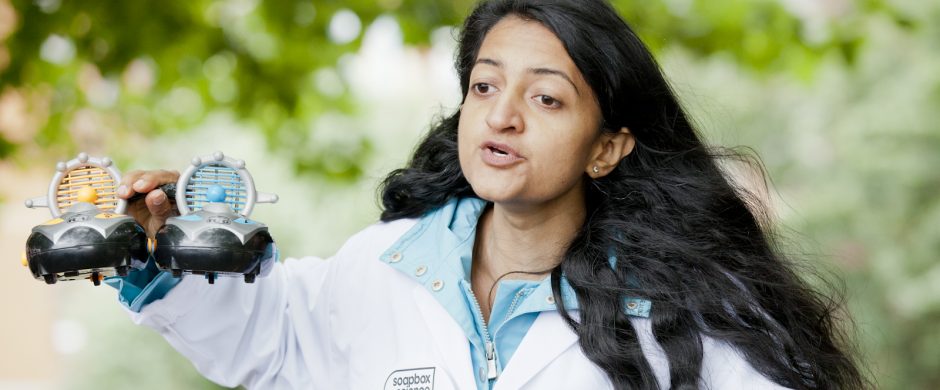

Natasha Zielazinski (right), a Composer, has been working with Dr Helen Barron (left)(@HelenCBarron), University of Oxford, towards Soapbox Art & Science Oxford 2017. Their topic is: “Your story: how does your brain remember?” You can catch them on Saturday 1st July alongside other artists and scientists at Magdalen college School, Oxford.
SS: How did you get to your current positions?
HB: I am a Junior Research Fellow in neuroscience at Merton College, University of Oxford. I got my current position in Oxford after doing a PhD in cognitive neuroscience at University College London (UCL).
NZ: I am a cellist and composer and work with contemporary repertoire, improvisation, field recording and folk music. I teach at the Guildhall School of Music & Drama and co-lead the Barbican Creative Learning ensemble Future Band, alongside work as a performer, composer and project leader with artists, orchestras and institutions in the UK and internationally. www.natashazielazinski.com
SS: What, or who, inspired your career choice?
NZ: Sound makes me feel free, whether I’m listening to sound or making it myself. I love the feeling of disappearing from normal time and finding another world, something I sometimes find in reading or cycling too. I also love the physical, visceral power of sound to call attention and bring people together. My own music comes from my connection with the cello and it’s resonance. Through my instrument I’ve found ways of exploring my own thoughts and feelings and expressing myself in the world. At other times it’s a vehicle that can take me into the head of another composer, whether it’s a friend or someone worlds away. And making music with others is incredible – it’s finding a way to be free with others, exploring, unearthing, and trying to communicate. I really believe that we are all artists – musicians, writers, painters, sculptors, composers, poets. It’s the most human thing in the world to feel something and want to express it. That I’ve ended up with a career as an artist is a wonderful thing. Nothing makes me happier than listening to music, learning a tune, composing sound or finding ways to share it with others.
HB: I was inspired to pursue a career in science by a number of different people. I think the earliest inspiration came from my dad who, as an acoustician, encouraged me to ask questions and seek to understand how the world works. Upon leaving school I knew that I wanted to pursue a science degree at university but at the time I enjoyed biology, chemistry and physics, and couldn’t decide which subject to focus on. To delay the decision I chose to pursue a broad Natural Sciences degree which allowed me to continue with a range of different science subjects. In my final year I finally settled on neuroscience, a relatively young subject which makes for an exciting research environment. I am grateful to my neuroscience supervisor, Dr Amy Milton, who introduced me to many of the fundamentals of neuroscience and provided a fantastic female academic role model for an undergraduate. Since this introduction to the subject I was fortunate to do my PhD in one of the UK’s most exciting and dynamic neuroscience labs, led by Professor Tim Behrens, which provided valuable training and opportunities in neuroscience research.
SS: What is the most fascinating aspect of your research/work?
HB: I am intrigued by some of the most basic neuroscience questions for which we still don’t have answers. For example, I am interested in understanding how we form new representations of the external world, and how our brains can store and recall hundreds of different memories. While I spend the best part of my week thinking about how to investigate these fundamental neuroscience questions, it is always fun to remind myself that my own brain is performing the very processes that I am investigating!
SS: What attracted you to Soapbox Art & Science in the first place?
HB: As I progress up the academic hierarchy the gender gap becomes increasingly apparent. The gender ratio in neuroscience, as estimated by the fantastic website biaswatchneuro.com, is around 1F:2M. While this may seem disappointingly low, it is even more disappointing to realise that visibility of women within the field is often even lower. Consequently, there are too few role-models for the younger generation and systemic gender discrimination persists. Soapbox Science appears to be one means by which women in science can be given a voice to encourage other women to have confidence in pursuing a scientific career. In addition, by collaborating with musician Natasha Zielazinski, Soapbox Art and Science has provided an opportunity to think about new ways in which we can communicate science to the public and provide inspiration for the next generation.
SS: What ideas are you working on together?
HB: Natasha and I are exploring ways in which we can explain neuroscience to the public through music and audience participation. While it is challenging to both understand and investigate the brain, we believe that some of the most fundamental principles of neuroscience can be communicated to the public through creative means. We have focused on exploring how audience members can act as neurons in the brain, and how “audience neurons” can then use music and song to illustrate how memories are stored.
SS: What would be your top recommendation to a woman studying for a PhD and considering pursuing a career in academia?
HB: Beyond seeking great labs to work in, my top recommendation to women studying for PhDs in STEM research is to not only be aware of gender bias, but to actively seek a female mentor who can help guide your career.
SS: What would be your recommendation for working with people from other subjects and disciplines?
NZ: Be curious, ask questions, find people you are interested in working with/learning from and be ready to test, experiment and get things wrong!
Soapbox Art & Science Oxford is kindly supported by the STFC, P2i and Oxford Festival of the Arts



